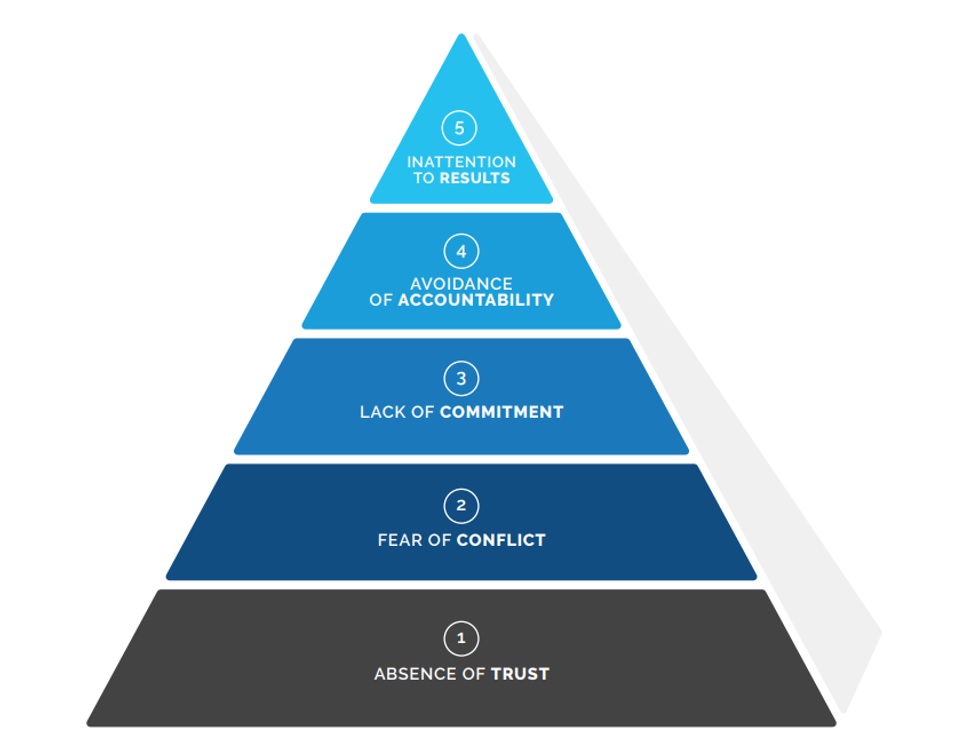This article discusses how FP&A teams can help our organisations measure information that balances the trade-offs...

In Patrick Lencioni’s 2012 book, “The Advantage”, the author claims that organisational health is the greatest advantage any company can achieve. He contrasts the advantages of healthy organisations with smart ones. “Smart” is about our fundamental skills, like finance, strategy and marketing. “Health” is about how communication flows throughout the organisation with clarity, minimum politics and confusion, high morale and productivity, as well as low employee turnover.
This article will explain how FP&A teams can help support organisational health, and we deep-dive into its four disciplines as stated in the book:
- Build a Cohesive Leadership Team
- Create Clarity
- Over-Communicate Clarity
- Reinforce Clarity
1. Building a Cohesive Leadership Team
A good way to assess if your leadership is cohesive is to compare your team to basketball and golf. In basketball, there is one ball, and the players need to know their roles and play well together for the team to win. There’s a lot of passing where we can be better together than as individuals, providing room for synergies where 1+1 can equal 3.
In golf, you can only add all the scores together and hope your team’s score beats the others. It is impossible to achieve synergies in golf, so 1+1 can only equal 2. Furthermore, like in basketball teams limited to 5 players, we have to limit the number of people in the leadership team for healthy and effective communication. Teams should typically comprise 3-7 people. Lencioni states that five behavioural principles are necessary for teams to function cohesively.
- Trust: By trust, we mean vulnerability-based trust, where we’re not afraid to share our opinions and respect the thoughts around us.
- Conflict: This one is counterintuitive, but we may have to disagree with others with respect rather than talking behind each other’s backs. Ask yourself if you’re willing to tell your disagreement to their face.
- Commitment: Once a decision is made, we will commit to supporting it even if we disagree.
- Accountability: We hold each other accountable for what we’re committed to.
- Results: If we do the first four things, results become somewhat inevitable.

Figure 1: The Five Dysfunctions of a Team. Source: ExecutiveAgenda.com/Patrick Lencioni’s Book
“The Five Dysfunctions of a Team”
I’ve been using Lencioni’s model, released in 2002, for 20+ years now, and it has helped me build many teams, particularly by giving direct feedback and embracing conflict as a strength. Before complaining about someone, I like to ask myself if I say what I’m saying directly to that person’s face. Feedback is such a critical element to team cohesiveness and development.
If you don’t tell someone that you perceive they are doing something wrong, you limit their opportunity for improvement. Furthermore, if you are in a dysfunctional team, treating others with the framework above can help the team become more functional, even if we’re not a direct leader of the team and lack formal authority.
Additionally, in FP&A, we get to play in multiple teams. We have our FP&A team, our business unit teams, and our cross-functional team, where we interact with other departments such as sales, operations, and human resources. I’ve previously explored the importance of such teams in my articles about having a seat at the table and teamwork and strategy. Applying the trust triangle to all your teams can make them better.
2. Create Clarity
The second requirement for building a healthy organisation, creating clarity, is all about achieving a company-wide alignment.
Lencioni addresses six critical questions:
- Why do we exist?
- How do we behave?
- What do we do?
- How will we succeed?
- What is most important right now?
- Who must do what?
The answers to these questions form the basis for a playbook. While these questions are simple, they can help us understand how the leadership team can get buy-in and support. There are a couple of takeaways here for FP&A.
First, we must be in tune with how the leadership team answers these questions. If we don’t know, we may struggle to implement our marching orders most effectively. For example, we may get directions like “hit the budget”. We can provide options on how to hit the budget, but as we monitor them, we can also ask how hitting the budget helps us support the organisational missions and strategic action plan. Knowing the current, most important initiatives can help us align with our cross-functional teams. For instance, three of our key initiatives right now are niche development, team incentives, and succession planning. Understanding how we can evaluate these initiatives is key to aiding the organisation and getting resource alignment to support the initiatives. Furthermore, all our forecasts have a significant judgement in them, as understanding the direction helps us build business models that can influence strategy.
Second, we must know the value that we provide ourselves as a department. I like to say we provide financial information for decision-making. Clarity in our own department’s value proposition is critical for success.
3. Over-communicate Clarity
How often have you felt you’ve told someone something, and they haven’t heard you? The key is to say it over and over again until they hear you clearly. It may require adjusting what you are saying to your audience. We may also need to show the numbers from different angles, using marginal compensation instead of average compensation to support the organisational goals. It might feel like we’re doing the same thing repeatedly, presenting the same numbers. Once our team members understand what we’re doing to be more influential and clearer, the stronger our message gets. For more information, see my prior article about real or fake news that numbers may bring.
4. Reinforce Clarity with Systems
Third, and maybe most importantly, we have to make sure that systems are set up to reinforce the organisation’s purpose. Here are three tools we utilise:
- Data and Metrics
- Reports and Meetings
- People and Organisational Structure
Data and Metrics
One of the great benefits of being in FP&A is that we get to present forward- and backward-looking numbers monthly. Once we understand where the company wants to go, we can frame our numbers to measure progress towards it. We can focus on Key Performance Indicators (KPIs), the current numbers and trends along with future ones. We can use ratio analysis to see if we’re achieving our goals. For example, is revenue growing faster than compensation? We can lead both by advocacy and inquiring. While sometimes recommendations are so obvious that we should just state them directly, it’s often better to ask those tough questions that can drive reflection and force our leaders to think.
Reports and Meetings
We are practising separating meetings between administrative (daily check-ins), tactical (weekly staff meetings), strategic (as needed), and developmental (quarterly reviews). FP&A needs to know the meeting cadence and how we communicate. We have regular weekly FP&A team meetings, and each business unit has monthly strategic meetings. We should also get people comfortable with our reports by providing them with a similar rhythm.
People, Organisational Structure, and Incentives
Whom we communicate with depends on how we are structured and incentivised. Individual effort can only take you to the point where changes in structure and incentives can melt steel. From an FP&A standpoint, we have to understand how people’s incentives affect their behaviour. For instance, how much of the team’s compensation is paid in salary versus bonus, and is compensation payment aligned with the overall mission?
While it’s not directly our responsibility to monitor this, asking questions and partnering with human resources to get better alignment between pay and the overall mission can definitely improve results and make your organisation healthier.
Conclusion
It’s easy to be smart. However, helping the organisation be healthier by leveraging communication and using sound numbers aligned with the company’s strategy may be FP&A’s ultimate value proposition.
Subscribe to
FP&A Trends Digest

We will regularly update you on the latest trends and developments in FP&A. Take the opportunity to have articles written by finance thought leaders delivered directly to your inbox; watch compelling webinars; connect with like-minded professionals; and become a part of our global community.






